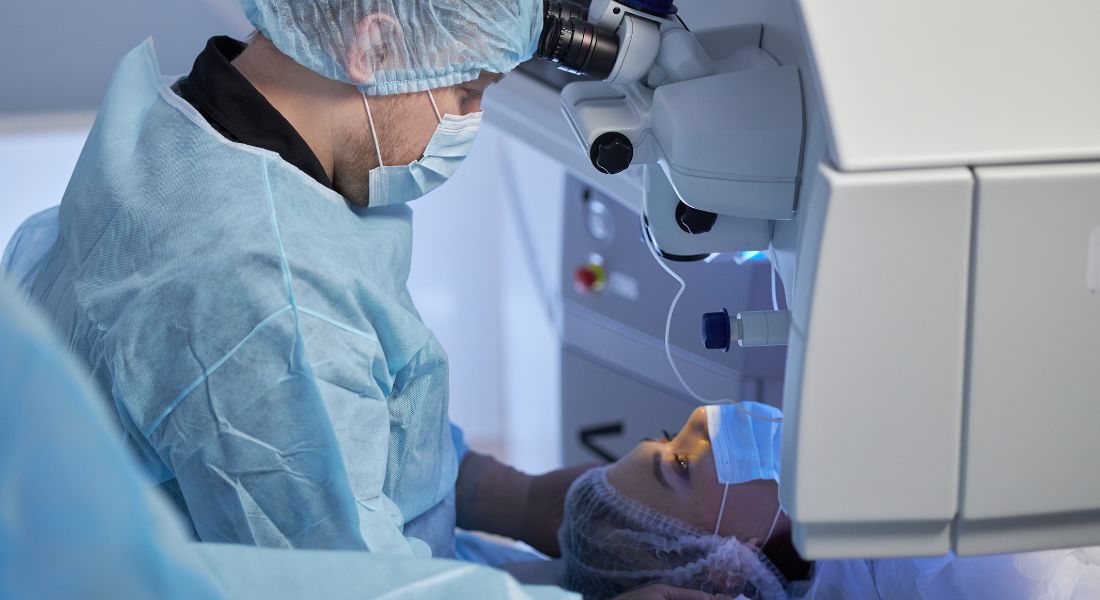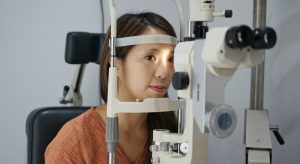LASEK Surgery for Far-Sightedness (Hyperopia): Is It Effective?

If you’re someone who’s far-sighted (hyperopic), you probably know exactly what it feels like to hold your phone at arm’s length just to make the text clear. You may struggle with reading, close work, detailed tasks, or even general comfort when switching focus. Perhaps your distance vision is still decent, but your eyes get tired easily, your reading glasses have become a constant companion, and you’re wondering whether laser eye surgery could give you more freedom.
Most people associate LASEK with correcting short-sightedness, but many far-sighted patients ask the same question: “Can LASEK treat hyperopia effectively?” The answer is: yes for the right patient. But hyperopia is more complex than myopia, and not everyone is automatically suitable.
In this article, I’ll walk you through everything you need to know about LASEK for far-sightedness. I’ll explain how the procedure works, why hyperopia behaves differently from myopia, what results you can realistically expect, how long the vision stays stable, and why some surgeons recommend alternatives for certain prescriptions. I’ll also compare LASEK to LASIK and other treatments so you can clearly understand your best options before making a decision. My goal is to give you all the knowledge you need to move forward confidently.
Let’s begin by looking at what hyperopia actually is and why it behaves differently in the eye.
What Is Far-Sightedness (Hyperopia)?

Hyperopia, also known as long-sightedness, occurs when:
- your eye is too short
- your cornea is too flat
- or the focusing power of the eye is too weak
Because of this, light entering the eye focuses behind the retina instead of directly on it.
What hyperopia feels like:
- difficulty focusing on near tasks
- eye strain when reading
- headaches or brow tension
- blurred near and intermediate vision
- difficulty switching focus
- tired eyes at the end of the day
Unlike myopia, hyperopia often worsens with age especially once your natural lens becomes stiffer (a condition called presbyopia). Laser surgery like LASEK aims to correct this focusing problem by reshaping your cornea so that light lands exactly where it should.
How LASEK Works for Hyperopia
To correct hyperopia, LASEK changes the curvature of your cornea in a very specific way. For hyperopia, the laser steepens the central cornea.
This increases its focusing power, bringing the focal point onto the retina.
The steps include:
- The epithelium (outer corneal skin) is loosened with an alcohol solution.
- The thin layer is moved aside.
- An excimer laser reshapes the cornea, steepening the centre.
- The epithelium is placed back.
- A bandage contact lens is applied for healing.
The entire procedure takes about 15–20 minutes per eye, and both eyes are usually treated on the same day. Because LASEK involves no flap creation, it is considered safer than LASIK for many patients especially those with thin or flat corneas.
Why Hyperopia Is More Challenging to Treat Than Myopia
Most clinics treat far more myopic patients than hyperopic ones. That’s because myopia responds more predictably to laser correction, whereas hyperopia presents some unique challenges.
Here’s why:
The cornea must be steepened, not flattened.
Steepening is biomechanically more complex and sometimes less stable over time.
Hyperopic corrections require larger optical zones.
his means more tissue needs to be reshaped.
Vision can fluctuate more during healing.
Especially for reading and intermediate distances.
Higher hyperopic prescriptions are harder to correct with surface treatments like LASEK.
This means certain patients may be better suited to LASIK, ICL, or refractive lens exchange.
Despite these challenges, modern LASEK techniques can still achieve excellent results for the right patient especially when using wavefront or topography-guided laser settings.
Is LASEK Effective for Treating Hyperopia?

The short answer is:
– Yes, LASEK can effectively treat mild to moderate hyperopia.
– Yes, it improves distance and near vision for most suitable patients.
– Yes, results are stable and long-lasting when done correctly.
However:
– High hyperopia is less suitable for LASEK.
– Recovery is slower than LASIK.
– Vision may fluctuate for several weeks.
– Let’s break this down more fully.
Who Is Suitable for LASEK When Treating Hyperopia?
You are likely suitable for LASEK if you:
- have mild to moderate hyperopia (+1.00 to +4.00)
- have a stable prescription
- have healthy corneas
- have enough corneal thickness
- are over 18
- do not have keratoconus or irregular topography
- have mild astigmatism
- want a flap-free procedure
LASEK is also ideal for people who:
- have thin corneas
- have dry eyes
- do contact sports
- want to avoid LASIK flap risks
For the right patient, LASEK provides excellent clarity and long-term safety.
Who Is NOT Suitable for LASEK for Hyperopia?
You may not be suitable for LASEK if you:
- have high hyperopia (above +4.00)
- have irregular corneas
- have thin corneas below safety thresholds
- have early or active keratoconus
- have very dry eyes
- need correction of presbyopia alongside hyperopia
- have large pupils that increase glare at night
In these instances, alternatives such as LASIK, SMILE (for specific prescriptions), or implantable lenses may be better.
What Results Can You Expect After LASEK for Hyperopia?
One of the most important questions patients ask is:
“Will LASEK improve both my distance and near vision?”
For most hyperopic patients, the answer is yes.
Results you can expect include:
- clearer distance vision
- reduced reliance on reading glasses
- sharper intermediate vision
- improved comfort during daily tasks
- reduced eye strain
- better focusing ability
Success rates for mild to moderate hyperopia are high:
- 90–95% achieve their desired visual result
- Most reach 20/20 or close to it
- Presbyopia may still develop later due to ageing
LASEK provides strong, predictable results for the right prescription range.
How LASEK Results Compare With LASIK for Hyperopia
This is an important comparison because both procedures reshape the cornea, but in slightly different ways.
LASIK for Hyperopia
- Faster recovery
- Immediate visual improvement
- Less discomfort
- Not suitable for thin corneas
- Greater risk of long-term dryness
- More risk of flap complications
LASIK is often used for higher levels of hyperopia because it allows for more precise reshaping.
LASEK for Hyperopia
- safer for thin corneas
- safer for dry eyes
- preserves corneal strength
- no flap complications
- slower recovery
- more discomfort
- slightly more fluctuation early on
Outcome quality:
Both LASIK and LASEK offer similar long-term visual results. The decision usually depends on corneal thickness, dryness, and lifestyle.
Recovery Timeline After LASEK for Hyperopia

Hyperopia recovery is slightly different from myopia recovery.
Here’s what to expect:
Day 1–3: Discomfort and Blurriness
- more discomfort than LASIK
- gritty feeling
- light sensitivity
- near vision may be blurrier than distance
- bandage contact lens remains in place
Day 3–5: Removal of Bandage Lens
Comfort improves noticeably.
Week 1–2: Distance Vision Improves Steadily
- clear distance vision
- near vision improving
- less strain
Weeks 3–6: Continued Visual Refinement
Hyperopic patients often experience the most fluctuation in this phase.
3 Months: Final Vision Clarity
Most patients achieve excellent clarity by this point.
6–12 Months: Long-Term Stability
Visual results remain stable for many years.
Will the Results Last? (Hyperopia Stability Explained)
One major concern for hyperopic patients is regression, where the eyes slowly shift back toward long-sightedness after laser surgery.
Hyperopic corrections are more vulnerable to regression than myopic ones.
Factors that improve long-term stability include:
- choosing the right procedure for your prescription
- using wavefront or topography-guided treatment
- treating both eyes simultaneously
- ensuring your corneas are structurally sound
- being over age 21 with a stable prescription
Many people maintain excellent vision for 10–20 years or longer.
How LASEK Compares With Other Hyperopia Treatments
If LASEK isn’t ideal for your eyes, there are several strong alternatives.
Let’s look at them.
LASIK for Hyperopia
LASIK is often preferred for:
- higher hyperopia
- patients wanting fast visual recovery
- people with thicker corneas
However, LASIK is less suitable for:
- thin corneas
- dry eyes
- flap-risk professions or sports
SMILE for Hyperopia
SMILE is not currently widely used for hyperopia. It is primarily designed for myopia and some astigmatism. Some advanced SMILE platforms are being tested for hyperopia correction, but they are not yet mainstream.
PRK (Photorefractive Keratectomy)
PRK is similar to LASEK, but the epithelium is removed entirely rather than repositioned. It may be used for hyperopia in limited cases, though LASEK is often preferred due to epithelial preservation.
Refractive Lens Exchange (RLE)
This is similar to cataract surgery.
Ideal for:
- middle-aged or older patients
- moderate to high hyperopia
- presbyopia
- combined vision needs
RLE replaces your natural lens with an artificial one, eliminating the risk of cataracts later.
Implantable Collamer Lens (ICL)
ICL is excellent for high myopia, but is less commonly used for hyperopia.
Special hyperopic ICLs exist, but availability varies by region.
Possible Side Effects of LASEK for Hyperopia
Most side effects are temporary and predictable.
Common temporary effects:
- dryness
- glare
- halos
- fluctuating vision
- delayed near focus
- discomfort for first few days
Rarer risks:
- undercorrection
- regression
- prolonged healing
- corneal haze
These risks are minimised when you choose an experienced surgeon.
Lifestyle Benefits of LASEK for Hyperopia
- No flap → safe for sports
- Better for dry eyes
- No cutting instruments
- Strong corneal stability
- Clear distance and near vision
- Ideal for younger adults needing safe correction
If you’re active, travel frequently, or work in environments where eye safety matters, LASEK is often a great fit.
FAQs:
- Can LASEK fully correct hyperopia?
LASEK can fully correct mild to moderate hyperopia in many patients, particularly those with prescriptions between +1.00 and +4.00. During the procedure, the laser steepens the central cornea so that light focuses accurately on the retina. While it works extremely well for lower prescription ranges, higher levels of hyperopia sometimes require alternative treatments such as LASIK or refractive lens exchange, simply because far-sightedness can be more complex to stabilise long-term. Still, for suitable candidates, LASEK provides clear, stable, long-lasting vision, with many achieving results close to 20/20. - Is LASEK safe for treating hyperopia?
Yes, LASEK is considered a very safe procedure for hyperopia, especially for people who have thin corneas, dry eyes, or active lifestyles where a flap-related complication from LASIK would be a concern. Because LASEK doesn’t involve creating a corneal flap, the structural integrity of the cornea remains stronger. The healing may take longer, but the overall safety profile is excellent. Complications such as haze or regression are uncommon and usually manageable with proper assessment and follow-up. - How long does recovery take after LASEK for hyperopia?
Recovery from LASEK is slower than LASIK, but most patients notice meaningful improvements in vision within the first one to two weeks. Near vision often fluctuates more because the eye needs time to adapt to the increased corneal curvature. It generally takes around two to three months for the final clarity to settle, and some hyperopic patients experience subtle refinements for several months beyond that. By the three-month mark, most people achieve the stable, clear results they expected. - Does LASEK improve both near and distance vision for hyperopic patients?
Yes, LASEK typically improves both near and distance vision for suitable hyperopic patients. Because the laser increases the cornea’s focusing power, tasks such as reading, computer work and working at arm’s length often become noticeably easier. Distance vision also becomes sharper, contributing to increased comfort throughout the day. The improvement in near vision can be especially significant for younger adults, although age-related changes such as presbyopia will still occur over time and may require reading glasses later. - Is the LASEK procedure painful?
The procedure itself is not painful because anaesthetic drops numb the eye. Most patients describe a feeling of pressure rather than discomfort. After the treatment, however, it’s normal to experience soreness, light sensitivity, watery eyes and a gritty sensation for the first two to three days. This is because the surface layer of the cornea is healing. A bandage contact lens is used to protect the eye during this stage, and medicated drops help control inflammation and discomfort. The majority of patients feel significantly better by day four or five. - How stable are hyperopia results after LASEK?
Hyperopia results are generally stable for many years, particularly when the procedure is performed on patients with appropriate prescription levels and healthy corneas. While hyperopic corrections can carry a slightly higher tendency for regression compared to myopia, advances in laser technology have improved long-term predictability. Choosing wavefront-guided or topography-guided treatment further enhances accuracy and stability. Most patients enjoy clear vision for 10 to 20 years or more, although natural ageing of the eye will eventually influence focusing ability. - Can LASEK treat hyperopia with astigmatism?
Yes, LASEK can effectively treat hyperopia combined with mild to moderate astigmatism. The excimer laser is capable of reshaping the cornea in a way that addresses both the curvature steepening required for hyperopia and the irregularity involved in astigmatism. This allows many patients to achieve clearer, more comfortable vision without needing glasses for everyday tasks. Very high astigmatism levels may require alternative procedures, but for most people with common prescription ranges, LASEK is a strong option. - Is LASEK better than LASIK for hyperopia?
Neither procedure is universally “better”; the choice depends entirely on the patient’s eye structure and lifestyle. LASIK provides faster recovery, less initial discomfort and often a quicker stabilisation of vision. However, LASEK is often preferred for people with thin corneas, dry eyes, flat corneas or those involved in sports where physical impact could risk a LASIK flap. In terms of long-term visual results, both procedures offer similarly high success rates. The ideal choice is based on safety, stability and the anatomy of the eye rather than which one is superior overall. - Will I still need glasses after LASEK if I’m hyperopic?
Many patients no longer need glasses for everyday distance tasks after LASEK, and many also find that near and intermediate activities become much more comfortable. However, whether you will ever need glasses again depends on several factors, including your original prescription, your age and how your vision changes naturally over time. Hyperopic patients who are older may eventually need reading glasses due to presbyopia, which affects everyone regardless of whether they have had laser eye surgery. - How do I know if I’m a good candidate for hyperopia correction with LASEK?
The best way to determine suitability is through a detailed eye assessment that examines corneal thickness, shape, prescription stability, tear film quality and overall eye health. Patients with mild to moderate hyperopia, a stable prescription, healthy corneas and no signs of irregularities such as keratoconus are often excellent candidates. People with thin corneas or dry eyes also tend to benefit from LASEK over LASIK. Your lifestyle, visual goals and long-term expectations also play a key role in deciding whether LASEK is the right treatment for you.
Final Thought: Is LASEK the Right Option for You?
Choosing the right treatment for far-sightedness is a highly individual decision, and understanding how LASEK works for hyperopia can help you take the next step with confidence. While hyperopic corrections are more complex than myopic ones, modern LASEK techniques offer excellent clarity, long-term stability and a safer option for people with thin corneas, dry eyes or active lifestyles. If you’re exploring your options, the most reliable way to know whether you’re an ideal candidate is through a detailed assessment of your corneal thickness, prescription and overall eye health. If you’re considering Lasek surgery and want to know if it’s the right option, you’re welcome to reach out to us at Eye Clinic London to book a consultation.
References:
- Ghadhfan, F., Al-Rajhi, A.A. & Wagoner, M.D. (2007) ‘Laser in situ keratomileusis versus surface ablation: Visual outcomes and complications’, Journal of Refractive Surgery, 23(3), pp. 244–254. Available at: https://pubmed.ncbi.nlm.nih.gov/17385263/
- Lee, J.B., Choe, C.M., Kim, H.S. & Seo, K.Y. (2001) ‘Comparison of laser epithelial keratomileusis and photorefractive keratectomy for low to moderate myopia’, Journal of Cataract and Refractive Surgery, 27(4), pp. 565–570. Available at: https://pubmed.ncbi.nlm.nih.gov/11311623/
- Alio, J.L., Artola, A., Claramonte, P., Ayala, M.J. & Sánchez, S.P. (1998) ‘Complications of photorefractive keratectomy for hyperopia’, Journal of Cataract and Refractive Surgery, 24(12), pp. 1562–1570. Available at: https://pmc.ncbi.nlm.nih.gov/articles/PMC1771479/
- Camellin, M. & Arba Mosquera, S. (2011) ‘Aspheric LASIK treatment of hyperopia: 6-month results’, Journal of Ophthalmology, Article ID 928751. Available at: https://pmc.ncbi.nlm.nih.gov/articles/PMC3145729/
- Alió, J.L., Soria, F.A., Abbouda, A. & Peña-García, P. (2020) ‘Laser refractive surgery for hyperopia: indications, techniques and limitations’, Journal of Clinical Medicine, 9(4), p. 1106. https://www.mdpi.com/2077-0383/9/4/1106

